![]()
![]()
![]()
Use LEFT and RIGHT arrow keys to navigate between flashcards;
Use UP and DOWN arrow keys to flip the card;
H to show hint;
A reads text to speech;
78 Cards in this Set
- Front
- Back
|
What are the most common types of esophageal atresia and fistulas
|

Esophageal atresia and tracheoesophageal fistula. A, Blind upper and lower esophageal segments. B, Fistula between blind upper segment and trachea. C, Blind upper segment, fistula between blind lower segment and trachea. D, Blind upper segment only. E, Fistula between patent esophagus and trachea. Type C is the most common variety
|
|
|
What are some of the major conditions associated with esophageal motor dysfunction
|
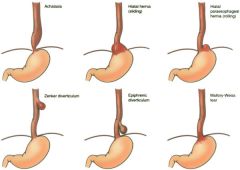
Major conditions associated with esophageal motor dysfunction
|
|
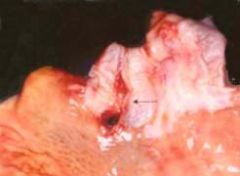
What does this picture demonstrate
|

Esophageal laceration (Mallory-Weiss tears). Gross view demonstrating longitudinal lacerations extending from esophageal mucosa into stomach mucosa (arrow)
|
|

What do these pictures demonstrate
|
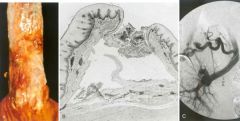
Esophageal varices. A, A view of the everted esophagus and gastroesophageal junction, showing dilated submucosal veins (varices). The blue-colored varices have collapsed in this postmortem specimen. B, Low-power cross-section of a dilated submucosal varix that has ruptured through the mucosa. A small amount of thrombus is present within the point of rupture. C, Hepatic venogram after injection of dye into portal veins (PV) to show a large tortuous gastroesophageal varix (arrow) extending superiorly from the patent main portal vein.
|
|
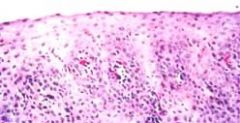
What does this picture demonstrate
|

Reflux esophagitis. Low-power view of the superficial portion of the mucosa. Numerous eosinophils within the squamous epithelium, elongation of the lamina propria papillae, and basal zone hyperplasia are present
|
|
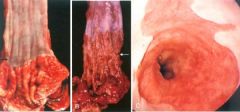
What do these pictures demonstrate
|

Barrett esophagus. A, B, Gross view of distal esophagus (top) and proximal stomach (bottom), showing A, the normal gastroesophageal junction (arrow) and B, the granular zone of Barrett esophagus (arrow). C, Endoscopic view of Barrett esophagus showing red velvety gastrointestinal mucosa extending from the gastroesophageal orifice. Note the paler squamous esophageal mucosa
|
|
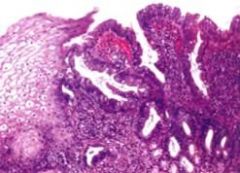
What does this picture demonstrate
|

Barrett esophagus. Microscopic view showing squamous mucosa and intestinal-type columnar epithelial cells (goblet cells) in a glandular mucosa
|
|

What does this picture demonstrate
|
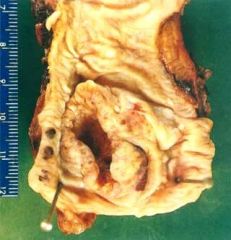
Large ulcerated squamous cell carcinoma of the esophagus
|
|
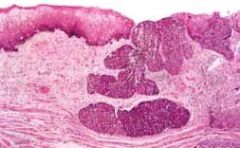
What does this picture demonstrate
|

Squamous cell carcinoma of the esophagus: low-power microscopic view showing invasion into the submucosa
|
|
|
What is the transition from Barrett esophagus to carcinoma
|

Transition from Barrett esophagus to adenocarcinoma
|
|

What do these pictures demonstrate
|
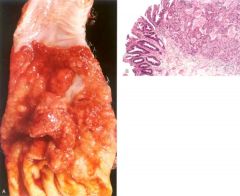
Adenocarcinoma of the esophagus. A, Gross view of an ulcerated, exophytic mass at the gastroesophageal junction, arising from the granular mucosa of Barrett esophagus. The gray-white esophageal mucosa is on the top, and the folds of gastric mucosa are below. B, Microscopic view of malignant intestinal-type glands in adenocarcinoma arising from Barrett esophagus
|
|
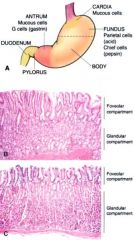
What is the normal anatomy of the stomach
|

Anatomy and histology of the stomach. A, Gross anatomy. B, Microscopic view of antral mucosa. C, Microscopic view of fundic mucosa.
|
|

What do these pictures demonstrate
|

Acute gastritis. A, Gross view showing punctate erosions in an otherwise unremarkable mucosa; adherent blood is dark due to exposure to gastric acid. B, Low-power microscopic view of focal mucosal disruption with hemorrhage; the adjacent mucosa is normal.
|
|
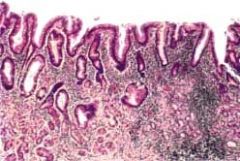
What does this picture demonstrate
|

Chronic gastritis, showing partial replacement of the gastric mucosal epithelium by intestinal metaplasia (upper left) and inflammation of the lamina propria (right) containing lymphocytes and plasma cells
|
|
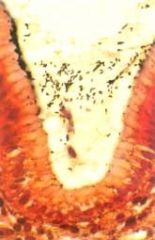
What does this picture demonstrate
|

Helicobacter pylori. A Steiner silver stain demonstrates the numerous darkly stained Helicobacter organisms along the luminal surface of the gastric epithelial cells. Note that there is no tissue invasion by bacteria.
|
|
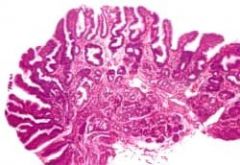
What does this picture demonstrate
|

Reactive gastropathy. Gastric mucosa, showing hyperplasia of foveolar surface epithelial cells, glandular regenerative changes, and smooth muscle fibers extending into lamina propria.
|
|
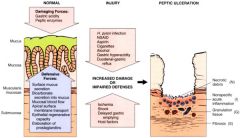
What are the causes of, and defense mechanisms against, peptic ulceration
|

Diagram of causes of, and defense mechanisms against, peptic ulceration. Diagram of the base of a nonperforated peptic ulcer, demonstrating the layers of necrosis (N), inflammation (I), granulation tissue (G), and scar (S), moving from the luminal surface at the top to the muscle wall at the bottom
|
|
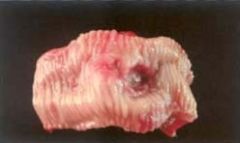
What does this picture demonstrate
|

Peptic ulcer of the duodenum. Note that the ulcer is small (2 cm) with a sharply punched-out appearance. Unlike cancerous ulcers, the margins are not elevated. The ulcer base is clean.
|
|
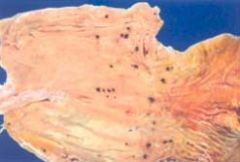
What does this picture demonstrate
|

Multiple stress ulcers of the stomach, highlighted by dark digested blood on their surfaces
|
|
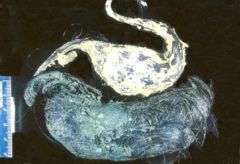
What does this picture demonstrate
|

Trichobezoar, showing agglomeration of hair, food, and mucus that occurred within the gastric lumen
|
|
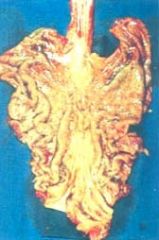
What does this picture demonstrate
|

Hypertrophic gastropathy, showing markedly thickened gastric folds
|
|

What does this picture demonstrate
|
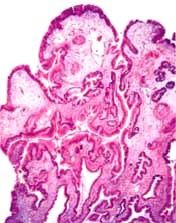
Gastric hyperplastic polyp. Low-power microscopic view of the polyp showing hyperplastic foveolar epithelium and inflammation
|
|
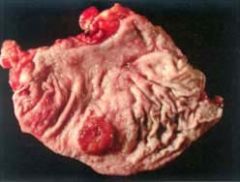
What does this picture demonstrate
|

Gastric adenoma. Gross photograph showing a large polyp in the stomach
|
|
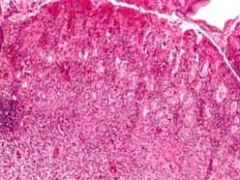
What does this picture demonstrate
|

Inflammatory fibroid polyp; microscopic photograph showing submucosal growth of inflamed vascularized fibromuscular tissue with prominent eosinophilic infiltrate.
|
|
|
What are the different growth patterns of gastric carcinoma
|

Diagram of growth patterns and spread of gastric carcinoma. In early gastric carcinoma (A), the tumor is confined to the mucosa and submucosa and may exhibit an exophytic, flat or depressed, or excavated conformation. Advanced gastric carcinoma (B) extends into the muscularis propria and beyond. Linitis plastica is an extreme form of flat or depressed advanced gastric carcinoma
|
|

What does this picture demonstrate
|
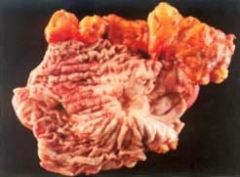
Gastric carcinoma. Gross photograph showing an ill-defined, excavated central ulcer surrounded by irregular, heaped-up borders
|
|

What do these pictures demonstrate
|

Gastric carcinoma. A, Intestinal type demonstrating gland formation by malignant cells, which are invading the muscular wall of the stomach. B, Diffuse type demonstrating signet-ring carcinoma cells
|
|

What does this picture demonstrate
|
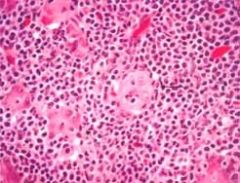
Gastric MALT lymphoma. Note the lymphoepithelial lesions (arrows)
|
|
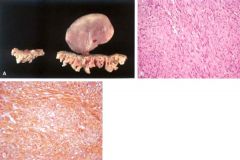
What do these pictures demonstrate
|

Gastrointestinal stromal tumor. A, Gross photograph of the tumor arising from the muscularis propria of the gastric wall. B, Microscopic view of the tumor showing spindle cell feature. C, Immunohistochemical stain showing the tumor cell c-KIT positivity
|
|

What do these pictures demonstrate
|

A, Normal small-bowel histology, showing mucosal villi and crypts, lined by columnar cells. B, Normal colon histology, showing flat mucosal surface and abundant vertically oriented crypts
|
|
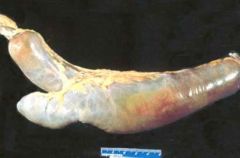
What does this picture demonstrate
|

Meckel diverticulum. The blind pouch is located on the antimesenteric side of the small bowel
|
|

What does this picture demonstrate
|

Shigella enterocolitis. Segment of colon showing pale, granular, inflamed mucosa with patches of coagulated exudate
|
|

What does this picture demonstrate
|

Pseudomembranous colitis from C. difficile infection. A, Gross photograph showing plaques of yellow fibrin and inflammatory debris adherent to a reddened colonic mucosa. B, Low-power micrograph showing superficial erosion of the mucosa and an adherent pseudomembrane of fibrin, mucus, and inflammatory debris.
|
|
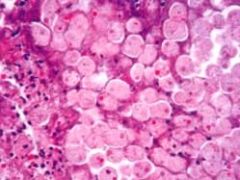
What does this picture demonstrate
|

Entamoeba histolytica in colon. High-power view of the organisms. Note some of the organisms ingesting red blood cells
|
|
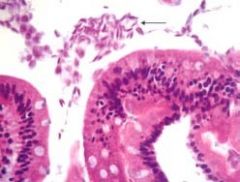
What does this picture demonstrate
|

Giardia lamblia. Trophozoite (arrow) of the organism immediately adjacent to the duodenal surface epithelium
|
|
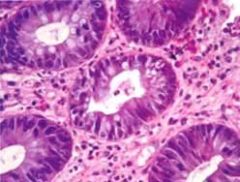
What does this picture demonstrate
|

Graft-versus-host disease of the colon. Note the apoptotic cell in the crypt (arrow).
|
|

What do these pictures demonstrate
|

Celiac disease (gluten-sensitive enteropathy). A, A peroral jejunal biopsy specimen of diseased mucosa shows diffuse severe atrophy and blunting of villi, with a chronic inflammatory infiltrate of the lamina propria. B, A normal mucosal biopsy
|
|
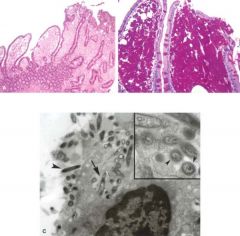
What do these pictures demonstrate
|

Whipple disease. A, Note foamy macrophages in the lamina propria. B, PAS stain showing the positive granules in the foamy macrophages. C, Electron micrograph of a lamina propria macrophage showing many bacilli within the cell (arrow) and in the extracellular space (arrowhead). Inset, Higher magnification of macrophage cytoplasm showing cross-sectional profiles of bacilli and their cell walls (small arrows).
|
|

What does this picture demonstrate
|
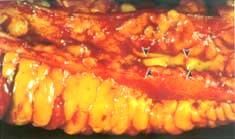
Crohn disease of ileum, showing narrowing of the lumen, bowel wall thickening, serosal extension of mesenteric fat ("creeping fat"), and linear ulceration of the mucosal surface (arrowheads).
|
|
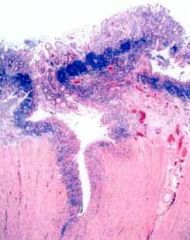
What does this picture demonstrate
|

Crohn disease of the colon; a deep fissure extending into the muscle wall, a second, shallow ulcer (on the upper right), and relative preservation of the intervening mucosa. Abundant lymphocyte aggregates are present, evident as dense blue patches of cells at the interface between mucosa and submucosa
|
|
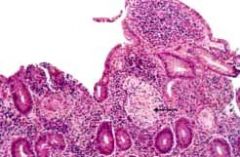
What does this picture demonstrate
|

Crohn disease of the colon. A noncaseating granuloma is present in the lamina propria of an uninvolved region of colonic mucosa (arrow).
|
|
|
Compare Crohn disease and ulcerative colitis
|
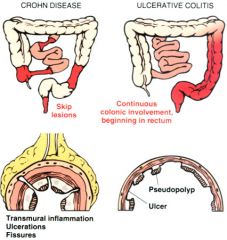
Comparison of the distribution patterns of Crohn disease and ulcerative colitis, as well as the different conformations of the ulcers and wall thickenings.
|
|
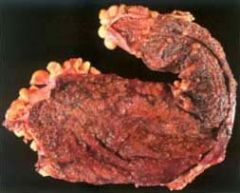
What does this picture demonstrate
|

Ulcerative colitis. Ulcerated hemorrhagic surface with knobby pseudopolyps
|
|
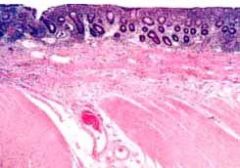
What does this picture demonstrate
|

Ulcerative colitis. Low-power micrograph showing marked chronic inflammation of the mucosa with atrophy of colonic glands, moderate submucosal fibrosis, and a normal muscle wall
|
|
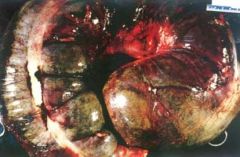
What does this picture demonstrate
|

Toxic megacolon. Complete cessation of colon neuromuscular activity has led to massive dilatation of the colon and black-green discoloration signifying gangrene and impending rupture
|
|

What does this picture demonstrate
|

Ulcerative colitis. Microscopic view of the mucosa, showing diffuse active inflammation with crypt abscess and glandular architectural distortion
|
|
|
What are the three types of acute ischemic bowel disease
|

Acute ischemic bowel disease. Schematic of the three levels of severity, diagrammed for the small intestine
|
|
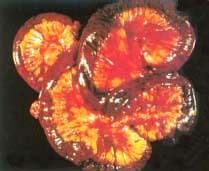
What does this picture demonstrate
|

Infarcted small bowel, secondary to acute thrombotic occlusion of the superior mesenteric artery
|
|
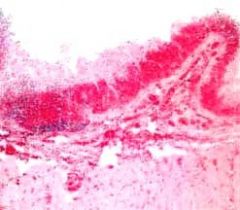
What does this picture demonstrate
|

Mucosal infarction of the small bowel. The mucosa is hemorrhagic, and there is no epithelial layer. The remaining layers of the bowel are intact
|
|
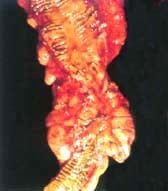
What does this picture demonstrate
|

Chronic ischemia of the colon, resulting in chronic mucosal damage and a stricture
|
|

What do these pictures demonstrate
|

Diverticulosis. A, Section through the sigmoid colon, showing multiple sac-like diverticula protruding through the muscle wall into the mesentery. The muscularis propria in between the diverticular protrusions is markedly thickened. B, Low-power photomicrograph of diverticulum of the colon, showing protrusion of mucosa and submucosa through the muscle wall. A dilated blood vessel at the base of the diverticulum was a source of bleeding; some blood clot is present within the diverticular lumen.
|
|
|
What are the four major causes of intestinal obstruction
|

Schematic depicting the four major causes of intestinal obstruction: (1) Herniation of a segment in the umbilical or inguinal regions; (2) adhesion between loops of intestine; (3) intussusception; (4) volvulus formation
|
|
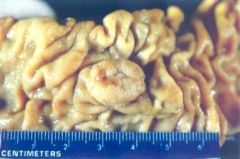
What does this picture demonstrate
|

Adenoma of the ampulla of Vater, showing exophytic tumor at the ampullary orifice
|
|
|
What are two forms of sessile polyps and two types of adenoma
|
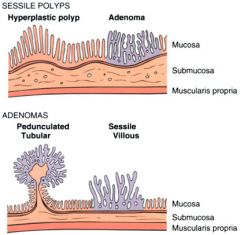
Diagrammatic representation of two forms of sessile polyp (hyperplastic polyp and adenoma) and of two types of adenoma (pedunculated and sessile). There is only a loose association between the tubular architecture for pedunculated adenomas and the villous architecture for sessile adenomas.
|
|

What do these pictures demonstrate
|

Non-neoplastic colonic polyps. A, Hyperplastic polyp; high-power view showing the serrated profile of the epithelial layer. B, Peutz-Jeghers polyp; low-power view showing the splaying of smooth muscle into the superficial portion of the pedunculated polyp.
|
|
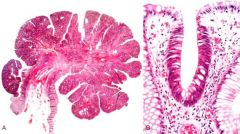
What do these pictures demonstrate
|

A, Pedunculated adenoma showing a fibrovascular stalk lined by normal colonic mucosa and a head that contains abundant dysplastic epithelial glands, hence the blue color with the H & E stain. B, A small focus of adenomatous epithelium in an otherwise normal (mucin-secreting, clear) colonic mucosa, showing how the dysplastic columnar epithelium (deeply stained) can populate a colonic crypt and create a tubular architecture
|
|
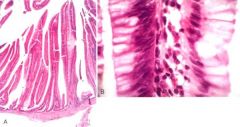
What do these pictures demonstrate
|

A, Sessile adenoma with villous architecture. Each frond is lined by dysplastic epithelium. B, Portion of a villous frond with dysplastic columnar epithelium on the left and normal colonic columnar epithelium on the right
|
|
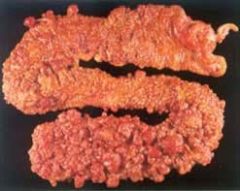
What does this picture demonstrate
|

Familial adenomatous polyposis in an 18-year-old woman. The mucosal surface is carpeted by innumerable polypoid adenomas
|
|
|
What are the morphologic and molecular changes in the adenoma-carcinoma sequence
|

Schematic of the morphologic and molecular changes in the adenoma-carcinoma sequence. It is postulated that loss of one normal copy of the tumor suppressor gatekeeper gene APC occurs early. Indeed, individuals may be born with one mutant allele of APC, rendering them extremely likely to develop colon cancer. This is the "first hit," according to Knudson's hypothesis. The loss of the normal copy of the APC gene follows ("second hit"). Mutations of the oncogene K-RAS seem to occur next. Additional mutations or losses of heterozygosity inactivate the tumor suppressor gene p53 (on chromosome 17p) and SMAD2 and SMAD4 on chromosome 18q, leading finally to the emergence of carcinoma, in which additional mutations occur. It is important to note that while there seems to be a temporal sequence of changes, as shown, the accumulation of mutations, rather than their occurrence in a specific order, is more important
|
|
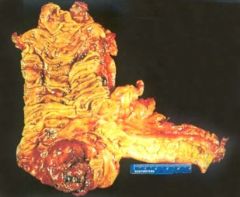
What does this picture demonstrate
|

Carcinoma of the cecum. The fungating carcinoma projects into the lumen but has not caused obstruction
|
|

What does this picture demonstrate
|
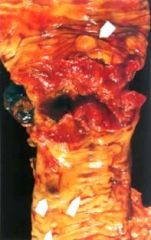
Carcinoma of the descending colon. This circumferential tumor has heaped-up edges and an ulcerated central portion. The arrows identify separate mucosal polyps.
|
|

What does this picture demonstrate
|
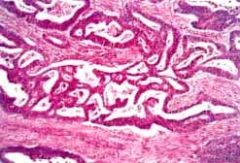
Invasive adenocarcinoma of colon, showing malignant glands infiltrating the muscle wall
|
|
|
How is colorectal cancer staged
|

Pathologic staging of colorectal cancer. Staging is based on the depth of tumor invasion
|
|

What do these pictures demonstrate
|

Carcinoid tumor. A, Multiple protruding tumors are present at the ileocecal junction. B, The tumor cells exhibit a monotonous morphology, with a delicate intervening fibrovascular stroma. C, Electron micrograph showing dense core bodies in the cytoplasm
|
|
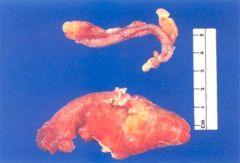
What does this picture demonstrate
|

Acute appendicitis. The inflamed appendix shown below is red, swollen, and covered with a fibrinous exudate. For comparison, a normal appendix is shown above.
|
|
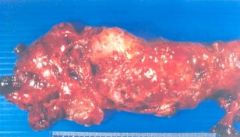
What does this picture demonstrate
|

Mucinous cystadenocarcinoma of the appendix, with spread into the immediate periappendiceal tissues
|
|
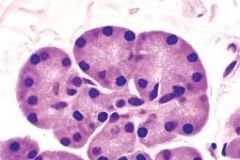
What do this pictures demonstrate
|

Pancreatic acini, showing the radial orientation of the pyramidal exocrine acinar cells. The cytoplasm is devoted to the synthesis and packaging of digestive enzymes for secretion into a central lumen
|
|
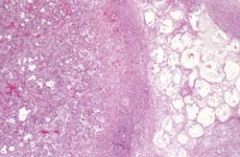
What does this picture demonstrate
|

Acute pancreatitis. The microscopic field shows a region of fat necrosis on the right and focal pancreatic parenchymal necrosis (center).
|
|
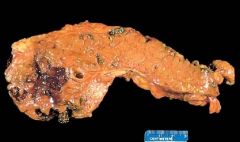
What does this picture demonstrate
|

Acute pancreatitis. The pancreas has been sectioned across to reveal dark areas of hemorrhage in the head of the pancreas and a focal area of pale fat necrosis in the peripancreatic fat (upper left).
|
|
|
What are three proposed pathways in the pathogenesis of acute pancreatitis
|

Three proposed pathways in the pathogenesis of acute pancreatitis
|
|
|
What are the different sequelae of acute and chronic pancreatitis
|
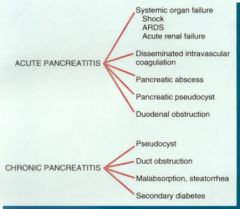
Comparison of the sequelae of acute and chronic pancreatitis. (ARDS = acute respiratory distress syndrome)
|
|

What do these pictures demonstrate
|

Chronic pancreatitis. A, Extensive fibrosis and atrophy has left only residual islets (left) and ducts (right), with a sprinkling of chronic inflammatory cells and acinar tissue. B, A higher-power view demonstrating dilated ducts with inspissated eosinophilic ductal concretions in a patient with alcoholic chronic pancreatitis.
|
|

What do these pictures demonstrate
|

Pancreatic pseudocyst. A, Cross-section through this previously bisected lesion revealing a poorly defined cyst with a necrotic brown-black wall. B, Histologically, the cyst lacks a true epithelial lining and instead is lined by fibrin and granulation tissue.
|
|

What do these pictures demonstrate
|

Serous cystadenoma. A, Cross-section through a serous cystadenoma. Only a thin rim of normal pancreatic parenchyma remains. The cysts are relatively small and contain clear, straw-colored fluid. B, The cysts are lined by cuboidal epithelium without atypia.
|
|

What do these pictures demonstrate
|

Pancreatic mucinous cystadenoma. A, Cross-section through a mucinous multiloculated cyst in the tail of the pancreas. The cysts are large and filled with tenacious mucin. B, The cysts are lined by columnar mucinous epithelium, and a dense "ovarian" stroma is noted
|
|

What do these pictures demonstrate
|

Intraductal papillary mucinous neoplasm. A, Cross-section through the head of the pancreas showing a prominent papillary neoplasm distending the main pancreatic duct. B, The papillary mucinous neoplasm involved the main pancreatic duct (left) and extending down into the smaller ducts and ductules (right).
|
|
|
What is the progression model for the development of pancreatic cancer
|

Progression model for the development of pancreatic cancer. It is postulated that telomere-shortening, and mutations of the oncogene K-RAS occur at early stages, that inactivation of the p16 tumor suppressor gene occurs at intermediate stages, and the inactivation of the p53, SMAD4 (DPC4), and BRCA2 tumor suppressor genes occur at late stages. It is important to note that while there is a general temporal sequence of changes, the accumulation of multiple mutations is more important than their occurrence in a specific order
|
|

What do these pictures demonstrate
|

Carcinoma of the pancreas. A, A cross-section through the head of the pancreas and adjacent common bile duct showing both an ill-defined mass in the pancreatic substance (arrowheads) and the green discoloration of the duct resulting from total obstruction of bile flow. B, Poorly formed glands are present in densely fibrotic stroma within the pancreatic substance; there are some inflammatory cells
|

